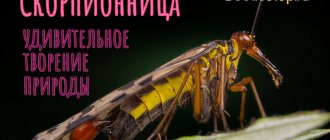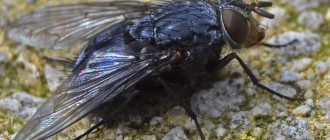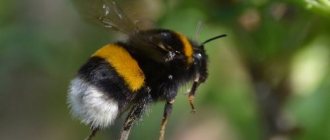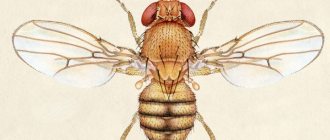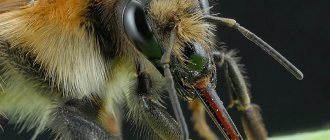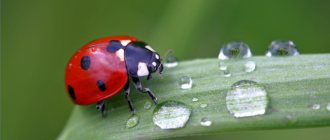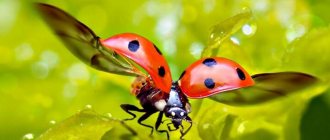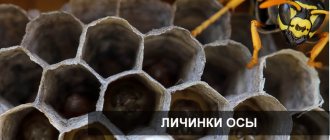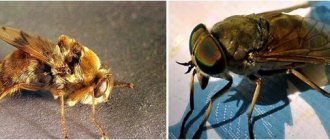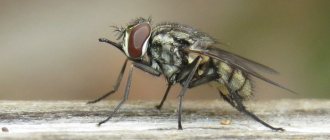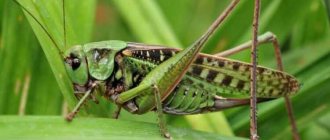Flies, like mosquitoes, are part of the order Diptera (Diptera), class Insects. They have two front wings, the hind wings have been transformed into balance organs - halteres.
Dipterologists (Diptera specialists) cannot name the exact number of species. It is known that 28 families of these insects number over 30 thousand groups.
Interesting fact. In a list of new species of plants and animals released by Australian scientists in 2022, some flies were named after heroes of the MARVEL multiverse.
Types and habitat of insects
Representatives of Diptera are distributed everywhere, except Antarctica and the Arctic zone, and live in the wild and near humans. The latter are called synanthropic and are divided into 3 groups:
- village: habitat – populated areas, for example, Musca domestica (indoor);
- semi-settlement: live and reproduce in settlements and in nature – Callphoridae (meat-bearing);
- pasture: develop in the droppings of cows and sheep on pasture - Wohlfahrtia magnifica (Wohlfahrtia).
Families and species
Dipterologists today distinguish the following groups:
Calliphoridae (Carrion)
- Calliphora vicina (blue redhead).
- Calliphora uralensis (blue meat).
- Lucilia sericata Mg. and Lucilia illustris Mg. (species of the genus green blowfly).
Area – Russia, Wed. Asia, Caucasus, Europe, North. America. The larvae of some species develop in carrion and cattle burial grounds no more than 1 meter deep, while others develop in cesspools. Adults feed on meat waste, feces, and fruits. You can meet them at bazaars and slaughterhouses.
Piophilidae (Cheese)
Scientists name about 100 species. Distributed everywhere, especially in areas where fishing is carried out. Fish, cheese, lard are the best places for the development of larvae, which grow up to 8 millimeters. If disturbed, they can jump up to 150mm.
Hippoboscidae (Bloodsuckers)
They live everywhere. There are about 800 species. Adult flies are blood-sucking. With paws equipped with serrated claws, they cling to birds, deer, dogs and other animals. Sometimes they attack people, causing skin inflammation.
Sarcophagidae (Grey meats)
Distribution: Europe, Asia, North Africa. There are approximately 3 thousand species. It reproduces on corpses, feces, manure, and food waste. Adult flies eat feces, meat, and fruits.
One of the most dangerous representatives of the family is the Wohlfart fly. She lays larvae on open wounds. By eating living tissue, parasites cause severe pain.
Oestridae (Gadflies)
Pasture insects. Maggots develop on the body of livestock and humans.
- Hypodermatinae (Subcutaneous). Doesn't live only in the Far North. The larvae penetrate the skin into the body and move through the tissues, causing skin lesions.
- Gasterophilinae (Stomach). Lives everywhere. Larvae enter the gastrointestinal tract with food and lead to inflammation of the stomach.
- Oestrinae (Cavity, nasopharyngeal). The larvae enter the mucous membranes, and from there into the pharynx and frontal sinuses, leading to miasma.
Drosophilidae (Drosophila)
Distributed everywhere. Midges can be seen in flower pots and bird nests. There are 1.5 thousand species. They feed on rotting plants. Maggots develop in spoiled vegetables and fruits, compotes, juices: apple, cherry, grape.
The most famous type. There are more than 5 thousand species in the world. The most common in Russia are:
- market;
- autumn fireweed;
- Room, house.
[edit] Anatomy
In the process of reproduction
| How does a fly land on the ceiling, from a loop or from a turn? |
| Film "Torpedo Bombers" |
Now we know the answer.
| - How does a fly land on the ceiling? “Before landing on the ceiling, she goes half-barrel into inverted flight, then RShG (step-throttle stick) all the way down, and bingo.” She has one problem - in inverted flight she has very little stability in the roll and pitch channels, but I think her emulsion force is good. |
| Comedians of one aviation forum |
Acrobats.
“Pugachev’s Cobra”, practical application The fly looks at you like a slipper The fly and its larvae are designed as ideal devices for processing all kinds of poo into useful fertilizer. A mature fly consists of a licking part (proboscis), compound eyes that provide almost full 360º vision, hairy legs, an abdomen, and wings, which are usually torn off by an amused junior schoolboy. It is believed that old man Aristotle counted eight legs in flies. And even in the Middle Ages, this misconception persisted in the minds and wandered from book to book, although it could be refuted by simply catching a fly and counting its legs without leaving the cash register. Such is the power of authority! However, this statement was not found in the texts of the philosopher himself.
A fly cannot bite off food. To eat, a fly must regurgitate its gastric juice onto the food, so that it can then be absorbed in a semi-liquid state. Spiders and predatory bugs do the same thing, but they give the victim a lethal injection and then suck out the contents of the skin. Biting flies, despite their external similarity, are a different species - autumn flies, which SUDDENLY become active in the fall. They are also incapable of biting, but they can scrape with their proboscis, which is also unpleasant.
All these insects have a proboscis, and they know how to use it. While eating, the fly's lower lip acts like a sponge, sucking food liquefied by vomited gastric juice into the mouth. Flies do not have a tongue, so their taste sensors are located on their legs, and they are much more sensitive than any modern technical detectors. Fans of anti-scientific crap even claim that a fly allegedly distinguishes between saccharin and sugar by just one molecule per drop of water. How its sensors come across exactly this single molecule in a drop comparable in size to the mandavokha itself remains unclear. Perhaps they find it by smell, but it is possible that they detect it by the noise it makes or visually, by a badge with an identification number. She could test the copper coin that Tsokotukha found for its copper content with an accuracy of ten millionth of a percent.
This insect is characterized by an increased desire to reproduce and is able to have sex within a day and a half after emerging from the pupa. It lives quickly and dies young in a week or two, but in one summer it can give birth to almost two dozen generations. It is estimated that if a pair of flies fuck in April, they will have approximately 191,010,000,000,000,000,000 offspring by August. If they are spread evenly over the entire surface of the Earth, they will cover it with a layer of about 14 meters. In one species of fly, the male gonads (we call them “eggs”) make up about 11% of the weight of the insect itself. For us humans, our heads weigh less.
An interesting phenomenon was discovered in the Drosophila fly - the sex of this creature is determined not by the chromosomes themselves (as, for example, in humans), but by the ratio between the number of sex and other chromosomes. After the witchcraft of the “fly lovers-misanthropes”, in the first stages of division of the unfortunate insect’s egg, it was possible to obtain not only half males and half females, but also creatures that could be, for example, 40% females and 60% males, etc.
Flies have different tastes. The housefly prefers pig manure due to its ideal consistency and moisture, but will not disdain others. This insect is afraid of the dark and does not like drafts. Confirmed by experiments. Desert tear flies get into the eyes of people and animals. Predatory fly flies ( overbrain from English.
“robber flies”) catch other insects in flight and suck them dry, which is extremely beneficial. Carrion flies, accordingly, prefer carrion, and blowflies like to lay larvae in wounds and ulcers on the body of animals. And since a person is also an animal, sometimes he gets it too. True, these animals only eat dead tissue, for which their cute larvae are used (even right now!) in medicine to cleanse the wound from the effects of suppuration. Beloved by genetic biologists, Drosophila loves rotten fruits, and in laboratories lives on a mixture of semolina, yeast, raisins and sugar.
Despite being assembled according to ancient models, the fly still defeats humans in the field of aerodynamics and viewing angle. The facet organs of vision rule in ways our inventors of advanced cameras and space tracking systems never dreamed of. True, due to the lack of optical focusing, the resolution of such eyes noticeably decreases with distance. So flies still cannot look well into the distance. But they can distinguish up to 200 frames per second versus a measly 25, which for humans already merge into a continuously moving image.
The flight characteristics of flies are beyond praise, as anyone who has tried to catch them can easily see. Thanks to the short body and complex action of the wings, the flight of flies is VERY maneuverable. True, for the same reasons, this flight is unstable and requires constant control, for which there are even separate organs - the halteres (the remnant of the second pair of wings). Flies cannot plan.
Houseflies sometimes find food by smell, although their sense of smell is not tuned to specific flavor aromas, and is perhaps ten times weaker than the sense of smell of dung flies. Sometimes houseflies are able to see their food, but this does not always happen, because their special, complex eyes, although they look at everything, do not look very closely. Therefore, flies often simply stumble upon something tasty. So, if a fly, absentmindedly walking along the kitchen table, accidentally steps on a drop of jam, the taste sensors located on its paws will inform its fly brain that it has encountered “Food”, and then it will immediately use its proboscis. If there are other flies nearby, then the one that has dined will not even think of crawling out in front of them like bees, dancing the “full belly” dance. The hunters for dinner will show themselves: the flies follow each other almost at random. What for a meal, what for destruction.
The use of this “herd instinct” is recognized as the most cost-effective way to control flies. It is enough to place several flies on the Velcro trap lying in wait for them, and their friends will gradually begin to flock together in order to “drink the same cup.” On the other hand, throw a healthy fly into a 3-liter jar and turn it over without closing the hole - the fly will very quickly find a way out at the bottom. The bee will die in this situation without finding the hole...
Old man Carl Linnaeus once took the trouble to calculate that the offspring of three flies would be able to eat a dead horse faster than a lion, that’s right!
House fly
Another name is room. There are 2 subspecies found on the territory of the Russian Federation: Musca domestica domestica (common) and Musca domestica vicina (southern).
Homeland - steppe regions Wed. Asia, but today it is widespread everywhere. Active mainly during the daytime. The life cycle is 8-20 days. Acceptable temperature is 23-25 degrees Celsius.
Important. Some specimens can survive the winter in an unheated room in an inactive state and continue activity as soon as the temperature rises to 10 degrees.
Insects are carriers of gastrointestinal diseases, tuberculosis, worms, and eye diseases. May cause serious tissue damage (myiases)
Morphology
Three sections of the body: chest, abdomen, head - are densely covered with hairs. The body of an adult is 6-8 mm, gray in color. The lower part of the abdomen is yellowish, along the top of the chest there are 4 longitudinal stripes.
On the chest there are three pairs of five-segmented limbs. The last segment has suction cups that help it move along walls and ceilings. The organs of taste and touch are also located here.
There are large compound eyes on the head, followed by 3 simple ocelli. The distance between the eyes is smaller in males than in females. In front are antennae, which are designed for orientation in space and sense of smell.
Licking-sucking oral apparatus - proboscis and jaws. Flies can only consume liquid food; solid food is first dissolved in saliva. Therefore, contrary to speculation, they cannot pierce human skin and drink blood. During the period of egg maturation, the female switches to protein food. How do flies appear?
Smell and description
The antennae on the head of a fly, oddly enough, are organs of smell. The insect sniffs and detects odors with its antennae at a distance of more than 500 meters .
Antennae on the head of a fly
Most types of flies have a pair of main wings and additional ones, the purpose of which is flight correction. Interestingly, some species have no wings at all!
Before eating, the fly moistens it with saliva, trying to dilute its consistency. Her stomach is unable to digest solid food.
Interesting: Interesting and surprising facts about Ancient Rome
The well-known house fly lays up to 150 eggs at a time. Since the lifespan of representatives of this species is about a month , they lay about 3,000 eggs during their life.
Stages of development
The number of stages is influenced by the type of development of the fly - viviparous or oviparous.
Most often it occurs in the following sequence:
- egg;
- larva (3 periods);
- chrysalis;
- imago (adult).
There is no first phase in viviparous species. The larvae develop in the abdomen of the female. A prominent representative is the gray blowfly.
Most insects are oviparous: houseflies, botflies, fruit flies and others.
Diptera are very fertile. The female can lay more than 100 eggs, and reproduction continues throughout her short life. During the year, 9-20 generations can change.
Laying eggs
How are houseflies born? It all starts with mating. Males use sounds made by their halteres to attract females. Individuals copulate.
For oviposition, the female chooses places that are most favorable for this stage of fly development: manure, human waste, carrion, cesspools, rotten meat, spoiled fruits and vegetables. Through the ovipositor, which is located at the end of the abdomen, it can lay 70-120 white eggs approximately 1.2 millimeters long at a time. Depending on the weather, representatives of the order Diptera are capable of laying up to 2 thousand eggs throughout their lives.
For a note. Not all insects manage to survive at all stages of development, hence such high fertility. Next, postembryonic development begins, which occurs in stages.
External structure
A fly is an insect that has a typical structure for representatives of this class of animals. The body consists of three sections - head, thorax and abdomen. Six walking legs are attached to the middle one. The housefly is small in size - up to a centimeter.
On the head there is one pair of antennae, eyes and a sucking mouthparts. Therefore, the fly is not able to eat solid food. The insect searches for liquid, which it draws in using its proboscis. The fly liquefies solid substances. To do this, the insect regurgitates onto the food. It is the vomit that contains digestive enzymes that make food suitable for absorption.
How does the larva develop?
The embryo is freed from the shell, and a white legless larva appears, which many mistakenly call a worm or caterpillar. Length - about 13 millimeters, pointed in front, truncated in back.
The formation of the larva takes place in 3 stages. On the third, the yellowish-white body becomes shiny and spines appear on it.
Maggots feed on the environment where the eggs were laid. They do not have a digestive system, so they absorb processed food after releasing a caustic substance.
The cycle is completed in 3-25 days, for some, for example, the humpback, up to 4 weeks. The maggot finds a cool place where metamorphosis begins - the pupa is born.
Pupa stage
The most passive period in fly breeding. The membrane hardens and a puparium is formed. Pupae cannot tolerate heat (over +40 degrees) and high humidity. If the ground does not dry out for a long time after rain, they die. Therefore, during the rainy seasons there are few flies.
Under favorable conditions, the tissues in the cocoon disintegrate and changes in the whole organism occur. After about 5 days at a temperature of +25 degrees, an adult individual appears - an imago, which after 36 hours is capable of reproducing offspring.
By summing up the time allotted by nature for each stage, you can find out how quickly house flies reproduce: from one week to a month.
Features of the reproductive organ
There are growths and formations on the male genitals. Charles Darwin tried to describe their function by examining an individual through a microscope. The scientist believed that they were needed to more successfully persuade a female to have sexual intercourse, as well as to get rid of the sperm of the previous partner.
Modern dipterologists have experimentally proven that education is needed in order to attract partners to copulation and not slip off when they mate.
Features of female reproductive organs
Each of the two large ovaries is a connection of oviducts, which are divided into segments in which follicles develop (in which the egg is formed). The process begins in the pupal stage and ends in the adult stage.
When the female lays eggs, the accessory glands connect to the oviduct and secrete a secretion with which the eggs are glued to the nutrient medium.
Viviparous species
This group includes almost all blowflies, including the Wohlfart fly, as well as the famous killer fly, the tsetse.
How do viviparous (carrion, blow) flies reproduce? They lay larvae of the first stage in fish, meat, feces, corpses, as well as in abrasions and wounds on the skin of people and animals. After 5-7 days, the larvae hide in the ground, away from light and heat, and turn into a pupa, and then into an adult.
On a note. Carrion species have been well studied, and this is successfully used by criminologists: if larvae are found on a corpse, then the time of death can be determined.
[edit] Gallery
[edit] They are so different...
- Millions of these fruit flies died for the sake of science
- Know the heroes by sight!
- Bloodsucking Horsefly
[edit] Flies in high art
- Velomukha
- An example of a fly comic. The rest is there
- Another example from the same source
- And further
- Fly in high art
- Fly in the film of the same name
- Honorary All-USA Fly
- Magazine "Fly" with Cheburashko-ninja on the cover
- Zipper - green intelligent fly
- Fly from the 1960 domestic film adaptation
- Painting by Konstantin Khudyakov
- Polish artist Igor Morski
Gadflies
In nature, there are 30 genera, including 176 species. They are often confused with horseflies, bumblebees and bees.
Appearance
Body length is 9 mm-2.5 cm. An adult has a wide head with large eyes and short antennae. There is no proboscis, or it is reduced. The legs are massive and short. The abdomen is round or conical. The entire body is covered with coarse hairs. The life of gadflies is short - approximately 22 days.
Classification
- Hypodermatinae (Subcutaneous). Adults lay eggs on the hair of domestic animals: horses, rams, cows. The hatched larvae penetrate the skin and move through the tissues. Before entering stage II, they gather under the skin, forming inflamed fistulas. Through them the larvae get to the surface.
- Gasterophilinae (Stomach). There are 2 ways for larvae to enter. Some females lay eggs on leaf food, and they enter the animal with food. Others - on the head and chest. The cattle, by biting and licking the skin, transfer the eggs into the digestive tract.
- Oestrinae (Cavity, nasopharyngeal). Females release eggs in flight, which land on the mucous membranes of the eyes and nose. People often suffer unwittingly: as a result, conjunctivitis (very dangerous for a child) and other diseases can develop.
Some scientists classify Cuterebrinae, the American subcutaneous gadfly, as a separate subfamily. They most often parasitize mice, hares, gophers, etc.
Danger to humans
Some subcutaneous species, such as Dermatobia hominis, attack humans. Bodfly larvae penetrate the skin, causing a lot of suffering. Cases have been recorded where a person died from the penetration of parasites.
Gadflies are inventive in attack: some distract, others attack. Their legs are soft, so you may not notice when a fly lands on your skin. But its bite is very painful, burning. Redness appears in this place and itching begins.
Human blood serves as a breeding ground for eggs. The hatched larvae, looking for a way out, move upward. If they get into the brain, death is inevitable.
What is a male dragonfly called?
Dragonfly should have previously sounded like strekotja*, then strekotja turned into “strekotya”, “dragonfly”. I understand that it is not phonetic processes that are at work here, but false etymology. Therefore, the husband of a chatter is an ordinary chatter.
A female dragonfly is called a male dragonfly, while a male dragonfly is called a male dragonfly. Of course, in colloquial speech they sometimes joke and can name a male dragonfly. Dragonfly in this species is a common name, but these individuals have no other name other than male dragonfly.
Meaning in nature
Despite the fact that flies are annoying insects that poison human life, they play an important role in nature.
- Representatives of Diptera are one of the links in the food chain. Let’s assume that this is a favorite treat for the flycatcher.
- The larvae process rotting waste, cleaning the planet and returning minerals to the soil.
- Many types of flies pollinate plants. For example, in spring and summer you can find a hoverfly or an ear fly feeding on the nectar of flower stalks.
Interesting fact. During the war, it was noticed that wounds on which fly larvae were deposited healed faster. The thing is that maggots secrete digestive juice, which destroys bacteria and dead tissue.
Prevention
Insects harm gardens, vegetable gardens, and park areas; young cuttings, leaves, and shoots, which people lovingly grow, especially suffer from the larvae.
In addition, flies are carriers of dangerous diseases. Breeding these insects is not worthwhile, so you need to follow simple rules:
- carry out regular cleaning;
- Take out the trash can every day, which must always be closed;
- do not leave food waste on the table;
- seal fruits, vegetables, meat, fish or put them in the refrigerator;
- monitor the condition of mosquito nets.
Knowing the patterns and characteristics of the reproduction of flies, you can choose effective means of combating them.
[edit] Flies and men in white
- Scientists are experimenting with genetic engineering on flies - adding, for example, skills to self-glow in the dark or an extra pair of legs. Thousands, millions, billions of fruit flies died for the sake of the progress of science and the development of genetic scientists. Due to their simple structure - only 8 chromosomes - they were very convenient to study. It's time to erect a monument. Although, to be more precise, scientists were primarily attracted not by the number of chromosomes, but by the speed of reproduction and ease of breeding these flies, when the result of the experiment can be seen in a matter of days. Drosophila larvae also have the so-called salivary glands. polytene chromosomes, characterized by their HUGE size, making them easy to look at and study. The purely arithmetic number of chromosomes played a role in cytogenetics experiments, when chromosomes were stained and their behavior was monitored using a conventional microscope. Still, 8 fly chromosomes are easier to see than 46 human chromosomes, especially not in a book, but on a preparation where they are all mixed up. Now that each chromosome can be colored with a separate dye, this is no longer relevant.
Here she is, a beauty, and here are her babies. Eating a baby cow
- The blowfly Cochliomyia hominivorax
troubles Pindostan cattle breeders because it likes to lay its larvae in wounds on the body of cows.
Accordingly, the larvae poison the wounds with their vomit, turning them into ulcers. Because of this, the little cow loses weight, there is simply no gain in milk yield, and the skin is worthless on market day. Then, at the instigation of the farmers, the evil fly-loving misanthropes studied the biology of these flies and came up with a savage way of fighting them, encroaching on the most sacred thing in a fly’s life - on the E
x. It turned out that a female blowfly can only mate once in its life, and that’s it. And then the insidious killers in white coats began to raise male blowflies on an industrial scale. They were well fed to make them more attractive to females, and then brutally irradiated with strong X-rays, causing the males to become infertile. Masses of sterilized males were then released into blowfly habitats. The pretty winged Don Juans successfully competed with skinnier wild males, sailed females, and... that’s all. Dynamo as it is. Females lost their virginity in exchange for bullshit instead of sperm, and that was the end of their contribution to reproduction. So the war between man and fly is sometimes sophisticated to the point of subtle perversion.
Details of the fly's epic fail in the English-language Pediwiki: tyts!
